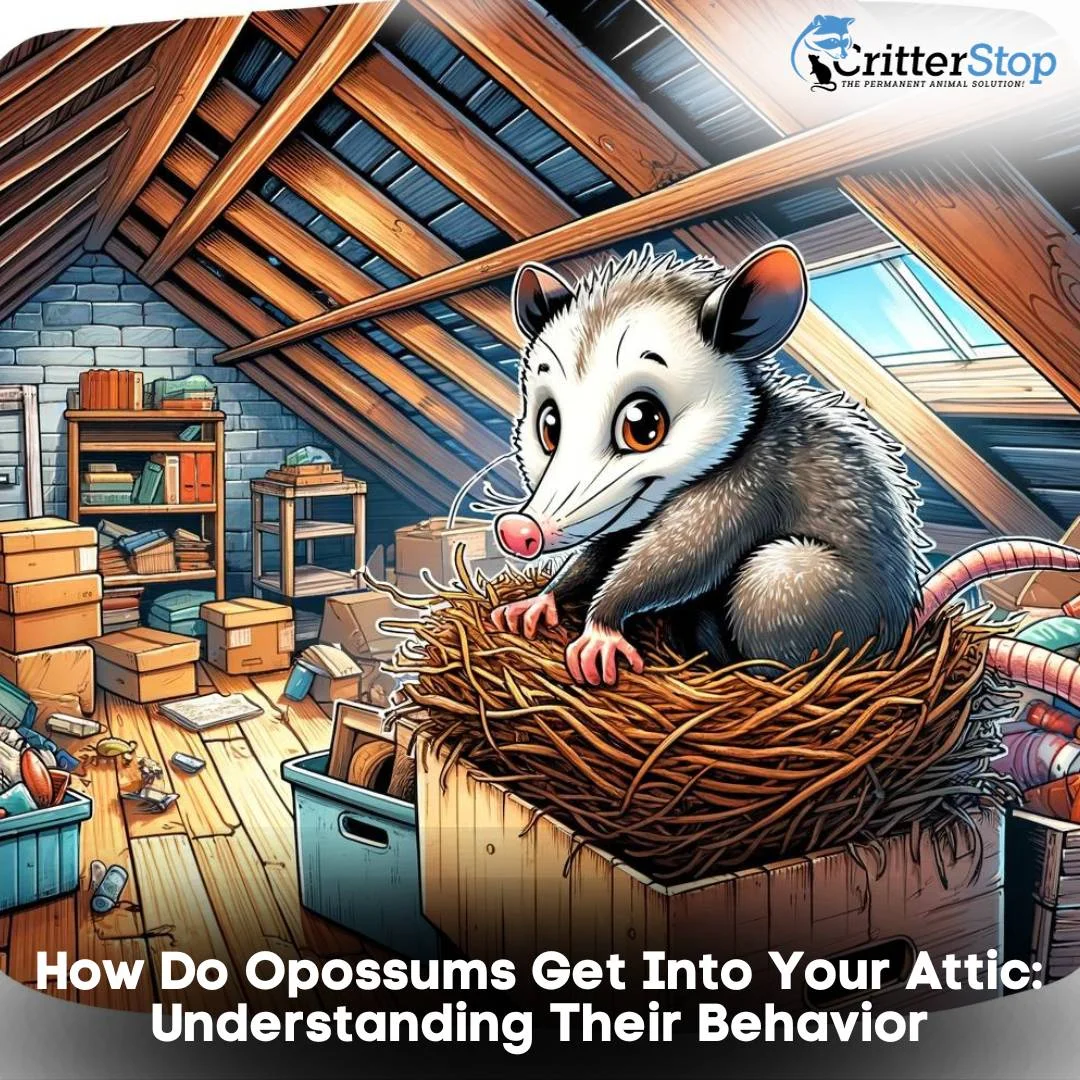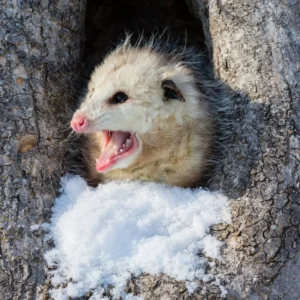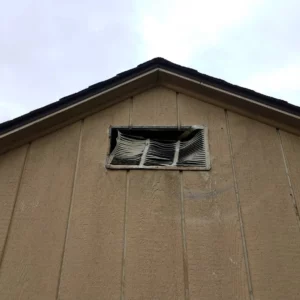
Opossums are curious creatures that often find their way into human dwellings, including attics. Understanding their behavior is essential in preventing these marsupials from making your attic their home. In this article, we will delve into how opossums gain access to attics, how to detect their presence, and what actions you can take to remove them.
Opossums are skilled climbers, making it relatively easy for them to scale trees and buildings. They can easily maneuver their way onto your roof by using overhanging branches, nearby structures, or even by climbing up downspouts and drainpipes. Once on the roof, they will search for any possible entry points into your attic.
When it comes to climbing, opossums have a unique advantage. They possess a prehensile tail, which means their tail is adapted for grasping and holding onto objects. This tail acts as a fifth limb, providing them with extra stability and support as they navigate their way up vertical surfaces. With their sharp claws and agile bodies, opossums can effortlessly make their way up to your attic, even in the most challenging of situations.

It's important to know how to identify if an opossum has taken up residence in your attic. One of the most common signs is the noise they make. Opossums are not light on their feet, and their movements can create distinct scratching and hissing sounds that can be heard from below. Additionally, foul smells may permeate the space, particularly if the opossum has been using it as a nesting area or a latrine.
Keep an eye out for droppings and urine stains as well, as these are also indications of an opossum's presence in your attic. Opossum droppings are typically cylindrical in shape and can be similar in size to that of a cat. They are often dark in color and may contain undigested food particles. Urine stains, on the other hand, can be identified by their strong odor and yellowish appearance.
Another telltale sign of opossum activity in your attic is the presence of nesting materials. Opossums are known to create nests using leaves, grass, and other soft materials. These nests are usually located in secluded corners or hidden areas of the attic, providing the opossum with a comfortable and secure place to rest and raise their young.
Furthermore, opossums are known to be opportunistic feeders, so if you have any food sources in your attic, such as pet food or bird feeders, they may be a magnet for these curious creatures. Keep an eye out for any signs of food consumption or damage to food containers, as this could indicate opossum activity.
If you notice any of these signs, it's time to take action to prevent further damage and potential health risks. Opossums can cause structural damage to your attic, chew through electrical wires, and carry diseases such as leptospirosis and tuberculosis. It is best to contact a professional wildlife removal service to safely and humanely remove the opossums from your attic and ensure that your home is secure against future invasions.
Having an opossum infestation in your attic can be a nuisance and cause damage to your property. It is important to be able to identify the signs of an opossum infestation so that you can take appropriate action. In this article, we will discuss some of the key indicators of an opossum infestation and how to prevent them from entering your attic.
One of the most noticeable signs of an opossum infestation in your attic is the presence of disturbing noises. Opossums are territorial animals and may make hissing or growling sounds when they feel threatened. These noises can be quite unsettling, especially if you hear them late at night when you are trying to sleep. Additionally, opossums are known to scuttle and scratch as they move around, so if you hear these sounds coming from your attic, it is a strong indication of their presence.
It is important to note that opossums are nocturnal creatures, meaning they are most active during the night. This is why you are more likely to hear their noises when it is dark outside. If you consistently hear hissing, growling, or scratching sounds coming from your attic, it is advisable to seek professional help to safely remove the opossums.

Another clear indication of an opossum infestation is the presence of foul odors. Opossums mark their territories with strong-smelling secretions, which can permeate your attic and other areas they frequent. The smell is unmistakable and can linger even after the opossums have been removed from your property.
The foul smell left behind by opossums can be quite unpleasant and may even affect the air quality in your home. It is important to address this issue promptly to ensure a clean and healthy living environment. Once the opossums have been removed, it is recommended to thoroughly clean and deodorize the affected areas to eliminate any lingering odors.
Knowing how opossums gain access to your attic is crucial in preventing their initial intrusion or future re-entry. Opossums can exploit existing entry points, such as damaged vents, loose shingles, or uncapped chimneys. They are also adept at creating new entry points by chewing through weakened areas of the building or squeezing through small gaps.
To prevent opossums and other wildlife from entering your attic, it is important to regularly inspect the exterior of your home for potential entry points. Look for any signs of damage or openings that could be exploited by opossums. Repairing damaged vents, securing loose shingles, and installing chimney caps are effective measures to prevent opossums from gaining access to your attic.
In addition to external entry points, it is also essential to inspect the interior of your attic for any openings or gaps that could serve as potential entry points. Opossums are known to squeeze through small openings, so sealing off any gaps or cracks is crucial in keeping them out. Using materials such as steel wool or caulk can help effectively seal off these entry points.
By being aware of the signs of an opossum infestation and taking proactive measures to prevent their entry, you can protect your attic and property from the damage and nuisance caused by these creatures. If you suspect an opossum infestation in your attic, it is recommended to contact a professional wildlife removal service to safely and effectively handle the situation.

If you've confirmed an opossum infestation in your attic, it's time to take action and have the animals removed. Opossums are nocturnal creatures that are known for their adaptability and ability to live in various environments. While they may seem harmless, having them in your attic can lead to a range of problems, including damage to your property and potential health risks.
While there are do-it-yourself methods available, it's often best to seek professional opossum removal services. These experts are equipped with the knowledge, experience, and tools necessary to safely and humanely remove opossums from your property. They understand the behavior and habits of opossums, allowing them to effectively locate and remove these animals from your attic.
Professional removal services also ensure that any structural damage caused by the opossums is assessed and repaired, preventing future invasions. Opossums can cause significant damage to insulation, wiring, and other components of your attic. By addressing these issues promptly, you can avoid costly repairs in the long run.
Additionally, professional opossum removal services can provide guidance on preventive measures to keep opossums and other pests at bay. They can advise you on sealing potential entry points, such as gaps in the roof or vents, to prevent future infestations. They may also recommend installing deterrents, such as motion-activated lights or sprinklers, to discourage opossums from approaching your property.
It's important to note that opossums are protected in some areas, and it is illegal to harm or kill them without proper permits. Professional removal services are well-versed in local regulations and will ensure that all necessary permits and guidelines are followed during the removal process.
In conclusion, understanding opossum behavior is key to preventing them from entering your attic. By being aware of how they gain access, detecting their presence, and taking appropriate action, you can ensure that your attic remains opossum-free. Remember, when dealing with an opossum infestation, it's essential to prioritize the safety and well-being of both humans and animals. Seeking professional opossum removal services is the most effective and humane way to address this issue and protect your property.